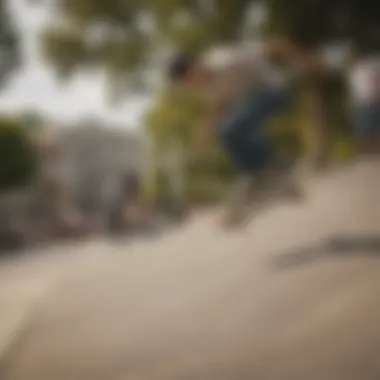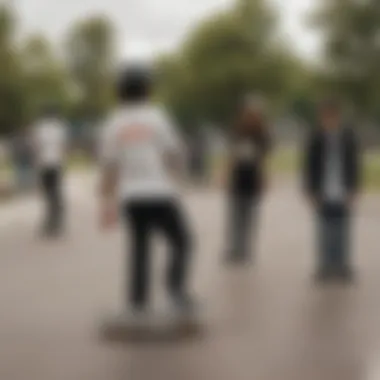Exploring the Culture of Skate America


Intro
Skate America represents more than just a sport; it's a vibrant tapestry of culture, community, and identity. In a world increasingly shaped by technology and mainstream phenomena, skateboarding stands as a bastion of creativity and individuality. This article aims to peel back the layers of this intriguing world, drawing attention to its roots and its far-reaching influence on society. From the iconic figures who have carved their names into skateboarding history to the essential gear that defines the sport, we will explore how skate America has evolved over the decades.
Understanding skateboarding is to grasp its unique dynamics. Whether you're haphazardly gliding down a street or perfectly executing a kickflip at your local skate park, each skater contributes to a shared passion. There’s something intimate about the notion of rolling on four wheels, breathing in the atmosphere of freedom and rebellion. This exploration isn't just a guide; it’s an invitation to appreciate a lifestyle that fosters camaraderie among skaters and links generations across the nation.
Essential Skateboarding Gear
When diving into the world of skateboarding, having the right gear is paramount. It serves not only as a practical necessity but also as a form of self-expression. Below, we look at top picks for skateboards and accessories.
Top Picks for Skateboards and Accessories
- Skateboards: Choosing the right skateboard can be a complete game changer. For beginners, a complete skateboard like the Element Section Complete offers a nice blend of durability and ease of control. Seasoned skaters might find the Baker Brand Decks provide a more robust experience.
- Trucks: The size and material of the trucks affect your ride and trick performance. High-quality options like Independent Trucks are favored for their durability and smooth turning.
- Wheels: Soft wheels (like 78A) are essential for smoother rides over rough pavement, while harder wheels offer better speed for street skating.
- Safety Gear: Never overlook the importance of protective gear. Helmets and knee pads are crucial in preventing injuries during practice.
Maintenance Tips for Longevity
Maintaining your skateboard is as vital as selecting the right components. A well-kept board enhances performance and extends its life. Here are some tips:
- Regularly check screws and bolts to ensure they are tight.
- Clean the wheels and bearings to maintain speed and control. A simple cleaning can involve disassembling the wheels and using a cloth to remove debris.
- Replace worn-out grip tape. Not only does it offer better traction, but it also adds a new aesthetic vibe to your skateboard.
Skateboarding Tricks and Tutorials
Once you’ve got the gear dialed in, it’s time to hit the pavement and start learning some tricks. Here’s what beginners and seasoned skaters alike should consider.
Beginner Tricks to Get You Started
- Ollie: This fundamental trick sets the stage for tons of others. Popping the tail while dragging your back foot up allows the board to lift.
- Shuvit: A fun trick that focuses on the board spinning 180 degrees underneath your feet while you jump.
- Kickflip: This trick requires a combination of foot technique and balance; a vital ingredient in a skater's repertoire.
Advanced Techniques for Seasoned Skaters
- 540 Shuvit: This trick adds another 360 degrees to the standard shuvit, demanding precise foot placement and timing.
- Heelflip: The flip is similar to the kickflip but involves your heel pushing the board. It’s about flicking your foot outwards and timing the jump just right.
- Backside Smith Grind: A grind that showcases style and control, this move requires skill in balance and trajectories on rails or ledges.
"Each trick you master is a tiny victory. They tell a story of perseverance and creativity, shaping not just who you are on the board but also in life."
In the realm of Skate America, it’s about more than just the tricks or the gear, it's about the community that surrounds it all. As you take your first steps—or rather rides—into skateboarding, keep in mind that every push forward is part of a grander journey.
Historical Context of Skate America
Understanding the historical context of skateboarding in the United States isn’t just about knowing dates and events; it’s about grasping how skate culture has evolved into a vibrant community that balances art, sport, and identity. This history illuminates the roots of today’s skating scene, revealing its implications on fashion, music, and social movements. By examining this evolution, readers can appreciate the significance of skateboarding as a cultural phenomenon rather than merely a recreational activity.
Origins of Skateboarding in the United States
Skateboarding as we know it began in the late 1940s and early 1950s when surfers in California sought to replicate the feeling of riding waves on land. They fashioned makeshift boards from old roller skates, attached to wooden planks. This early era, often dubbed the "sidewalk surfing" period, laid the groundwork for what would become a revolutionary sport. It wasn’t until the 1960s that skateboarding gained serious traction, with companies like Makaha and Roller Derby manufacturing complete skateboards. The introduction of new materials such as polyurethane wheels changed the game, leading to smoother rides and greater versatility.
The Evolution of Skate Culture
Key Milestones
Moving from its playful beginnings, skate culture saw key milestones that shaped its identity. The 1970s saw the first skateboard competitions, like the “Fiberflex Bowl-A-Rama,” sprouting a community around freestyle tricks and pool skating. The genesis of the skateboard magazine, particularly "Thrasher," in 1981 created a platform for skaters to share their stories, while the arrival of the Z-Boys in Dogtown revolutionized skateboarding style with their aggressive techniques.
These milestones serve as a testament to the resilience and innovation in skateboarding. They helped forge a sense of belonging among skaters, showcasing that the sport was as much about expression as it was about competition.
Influential Figures
The influence of pivotal figures like Tony Hawk, Stacy Peralta, and Rodney Mullen cannot be understated. Hawk's impressive aerial tricks and Mullen’s mastery of flat-ground techniques not only inspired generations of skaters but also elevated skateboarding to the mainstream. Each contributed their individual flair, setting the stage for a culture rich with diverse styles and approaches.
Their stories resonate with aspiring skaters and enthusiasts alike, providing a lasting platform from which new talents can emerge. They are reminders that the evolution of skate culture depends heavily on those who dare to push boundaries, making it a constantly evolving narrative.
Skateboarding in Popular Media


Documentaries
Documentaries, such as "Dogtown and Z-Boys," offer an insightful look into the roots of skate culture. They chronicle the lives of the Z-Boys—a group of young skaters who took the art of skating to new heights in the 1970s. Their struggles and successes are depicted with raw authenticity, showcasing not only the thrill of the sport but also the socio-economic realities of that time.
These documentaries serve as a bridge between history and present-day skating, providing viewers with a deeper appreciation for the craft while promoting the sport to new audiences. They can also inspire conversations around the art and ethics of skating.
Films
Films like "Lords of Dogtown" dramatize the history of skateboarding in a way that engages a broader audience. While fiction is blended with reality, the core message remains intact: skateboarding is more than just tricks; it’s a culture rooted in rebellion and creativity. The narratives presented often paint the struggle of youth against societal norms, lending a voice to a subculture that thrives on independence.
In doing so, films serve as gateways for newcomers, allowing them to step into the world of skateboarding while igniting nostalgia in veterans. They create a cultural lexicon that fosters attachment and community for skaters worldwide.
Television
Television, through shows like "Tony Hawk’s Boom Boom HuckJam," has played an integral role in popularizing skateboarding. Featuring various skateboarding talents, these programs bring the excitement of live competitions right into homes. This accessibility helps demystify the sport, offering insights into the lives of professional skaters.
The wide reach of television allows skateboarding to be recognized not just as an extreme sport, but as a significant cultural movement. As the stories and personalities of skaters gain air time, they further enrich the narrative surrounding skate culture, drawing in diverse audiences and contributing to its evolution.
Through these mediums—documentaries, films, and television—skateboarding has become not only a sport but a multifaceted cultural expression, showcasing the shared language of those who live and breathe skate America.
Key Elements of Skate Boarding
Skateboarding isn’t just about riding a board. It involves a culture, a community, and a sense of identity that goes beyond the physical activity itself. Understanding the key elements of skateboarding can help to appreciate the nuances of this vibrant sport. In this section, we’ll look closely at essential gear and equipment, as well as various styles of skateboarding.
Essential Gear and Equipment
Types of Skateboards
When you consider types of skateboards, there’s a whole smorgasbord to choose from, each designed to serve a specific riding style or preference. The most common ones are the standard popsicle shape, which is favored by street skaters, and the cruiser boards, which are more suited for commuting. The followers of different styles might gravitate towards specific boards based on their goals and personal experiences.
For instance, the standard popsicle shape often comes with a symmetrical design, allowing for easy flipping and tricks in both directions. This characteristic makes it popular among younger skaters and those who enjoy a more aggressive approach to skateboarding. On the other hand, cruiser boards often have wider decks and soft wheels, making them ideal for comfort during leisurely rides.
"Choosing the right skateboard is akin to picking the right pair of shoes; comfort and function are key."
However, each type of board comes with its pros and cons. The agility of standard skateboards may suit some, while the stability of cruisers appeals to others. In summary, the right board is ultimately dictated by the skater’s personal style and goals.
Safety Gear
Delving into safety gear is paramount for anyone serious about skating. Wearing a helmet is non-negotiable, but there are other essential protective items that shouldn’t be overlooked, such as knee pads and elbow pads. Safety gear isn’t just pieces of plastic and foam; they serve as lifelines during those inevitable wipeouts.
The key characteristic of safety gear is its ability to minimize injuries. The helmet, for example, protects the most vital part of the body—the head. Its role in preventing concussions is fundamental, especially for those venturing into tricks and high speeds.
Unique to safety gear is the variety of options available. From sleek designs that don’t hinder vision to more robust models with added padding, there’s something suitable for every kind of skater. While some may perceive such gear as cumbersome, it plays an immense role in instilling confidence. Skaters can push their limits knowing they have some cushioning against the fall.
Different Skateboarding Styles
Street
Street skating embodies the very essence of urban culture—it thrives in city environments, sculpting ordinary urban settings into skate-friendly havens. It relies heavily on creative approaches to navigating obstacles like stairs, curbs, and rails. Street skating is characterized by its improvisational nature, which can be appealing to those who seek individuality and flair.
What sets street skating apart is its urban aesthetic and sense of community that often forms around it. Skaters share tips, film videos together, and build camaraderie while challenging themselves against public spaces. But sometimes, this style carries its share of risks, like navigating potential legal issues over where to skate.
Vert
When one thinks of vertical skating, images of ramps and half-pipes come to mind. Vert skating focuses on tricks executed in the air, utilizing high walls for flips, grinds, and aerial maneuvers. The characteristic of vert skating is its specialized approach, demanding a specific type of equipment and skill set.
The thrill of vert skating lies in the adrenaline rush it provides. However, it is essential to consider that mastering vert techniques often involves a learning curve and a commitment to practice.
Cruising


Cruising offers a more laid-back experience—it's simply about rolling down the streets, enjoying the movements. Often accompanied by some ambient music or even a group of friends, this style emphasizes the journey rather than the tricks. The board used is typically designed for comfort, featuring soft wheels that protect against the jarring of cracked pavements.
What distinguishes cruising is its accessibility. It invites newbies to hop on a board, making it feel less intimidating than the other styles. While cruising may not boast the flashy tricks of street or vert styles, it represents a culture of tranquility and enjoyment that many skaters cherish.
Influential Skateboarding Communities
Skateboarding isn't merely a sport; it's a rich tapestry woven from various communities that define and nurture its culture. These communities play a critical role in shaping the landscape of skateboarding in America. They serve as rallying points for enthusiasts, offering a platform for expression, collaboration, and a sense of belonging. The influence of these skater communities goes beyond mere camaraderie; they are vital in fostering talent, promoting safety, advocating for skateboarding rights, and nurturing the next generation of skaters.
Famous Skateparks Across America
Skateparks stand as the beating heart of skateboarding communities. Places like the Embarcadero Plaza in San Francisco and Burnside Skatepark in Portland are more than just concrete and rails; they are cultural landmarks where skaters gather, share tricks, and inspire each other. These parks host countless impromptu sessions, competitions, and even social events. The design of these parks often embodies the values of their local communities. For instance, Burnside was built entirely by the skateboarding community, reflecting their dedication and spirit.
Moreover, parks like Skatepark of Tampa and The Berrics in Los Angeles attract international attention, becoming meccas for skaters across the globe, influencing styles, trends, and the overall skate culture. Each park has its own distinct vibe and character, often shaped by the local skaters' unique styles and preferences. This reinforces the notion that skateboarding is not just about individualistic pursuits but about shared experiences and growth.
The Role of Skateboarding Organizations
Organizations such as the Skateboarding Hall of Fame and Skate Like a Girl play pivotal roles in the skateboarding community. They work diligently to promote and preserve skateboarding culture. These organizations provide resources for education and safety while also fostering inclusivity.
"Skateboarding is an art, and organizations help nurture that creativity," as one skater passionately stated.
By organizing events, competitions, and workshops, they create platforms where skaters can connect, learn, and grow. Advocacy for skateboarding rights is equally significant; these groups work to ensure that skateboarding spaces remain accessible and safe for all. Their efforts highlight the importance of community in keeping the culture alive and thriving.
Local Skateboarding Clubs and Events
Local skateboarding clubs are often the backbone of skate communities. Clubs can vary from big-city collectives to smaller, neighborhood groups. They offer a range of benefits, from group skate sessions that encourage beginners to seasoned skaters sharing tips and tricks. Events organized by these clubs, like local competitions, fundraisers, and charity events, often unify the community and help promote skate culture further.
For instance, the Santa Cruz Skate Club hosts regular events that encourage participation from skaters of all ages and abilities. These gatherings not only build community spirit but also contribute to the local economy.
The Skate America Events
The events surrounding Skate America play a crucial role in understanding the entirety of skateboarding culture. These gatherings aren't just about competition; they encapsulate the spirit, the passion, and the camaraderie that bind skaters together. Events like these provide opportunities for skaters to showcase their skills, network with fellow enthusiasts, and inspire newcomers to the sport. Each competition has its unique flair, contributing to the rich tapestry of skateboarding as a cultural phenomenon.
Overview of Major Competitions
Skate America
Skate America stands out as a significant competition within the skateboarding community. As one of the country’s premier events, it attracts some of the brightest talents in the sport. This event is not just about competition; it embodies a celebration of skateboarding itself. The energy is palpable, and the community spirit is infectious, making it a must-attend for any skating fan.
One of the key characteristics of Skate America is its inclusivity. It welcomes skaters of all levels, from seasoned pros to eager newcomers, which enriches the competitive landscape. This diversity promotes healthy competition and collaboration among participants.
What's notably unique about Skate America is its emphasis on innovation. The competition often showcases the latest tricks and techniques, serving as a platform for skaters to push the boundaries of what’s possible on a skateboard. However, one downside could be the pressure it places on younger skaters who may still be finding their footing in the sport. Regardless, those who participate come away with invaluable experiences and lessons learned.
Games
The X Games is another heavyweight in the realm of skateboarding competitions. Known globally, it has transformed the scene into a spectacle of high stakes and even higher rewards. What makes it particularly exciting is its broadcast presence, reaching audiences far beyond the skateboarding community. This not only elevates the status of the skaters but pushes the sport itself into the mainstream
The key characteristic of the X Games lies in its professional caliber. Top-tier athletes from all over compete for glory, which creates an atmosphere thick with adrenaline and excitement. It is a platform where performances can lead to sponsorships and fame, undoubtedly a huge draw for skaters.
X Games also has a unique feature in its variety of events, including street, vert, and even freestyle BMX. This diversifies the competition and allows participants to express their unique style and skills. However, this level of competition can be daunting for some, often leading to injuries and burnout among competitors
The Impact of Competitive Skateboarding
The impact of competitive skateboarding ripples through the entire community. For many skaters, these events serve as a catalyst for growth and development, both personally and artistically. They allow for the sharing of skills, creation of new friendships, and formation of lifelong connections in a world where camaraderie is cherished. Moreover, they inspire the next generation of skaters, providing them with role models to look up to.
The competitive scene has also given rise to a new business model within skateboarding, where events lead to sponsorships and collaborations, further intertwining commerce with culture.
This merging of competition and culture emphasizes the importance of support systems, as skaters motivate each other to perform at their best. The stories that emerge from these events illustrate resilience, creativity, and a sense of belonging that remains a pillar of the skating community.
Through all these aspects, one can see that the Skate America events are more than just contests. They are essential to the essence of skateboarding, where competition, innovation, and community blend seamlessly into a vibrant celebration of the sport.


Skateboarding Trends and Innovations
In the ever-evolving landscape of skateboarding, trends and innovations play a vital role. These elements not only shape the sport's aesthetics but also dictate its functionality and cultural significance. Keeping up with trends means embracing change, and for skaters, this is crucial in maintaining relevance and improving skills.
Emerging Trends in Skateboarding
As the skateboarding scene continues to surge, certain trends are emerging that redefine how we perceive and practice the sport. One of the most notable trends is the rise of electric skateboards. These boards, equipped with batteries and motors, are transforming the traditional way of skating, appealing particularly to urban commuters who want to combine practicality with personal expression. While purists may scoff, the popularity among new skaters speaks volumes about the sport's adaptability.
Another trend making waves is the integration of sustainability into skateboarding. With increasing awareness of environmental issues, many brands are exploring materials that reduce ecological footprints. Skateboards made from recycled plastics and sustainably sourced wood are popping up on store shelves, reflecting a conscious effort to create a more responsible culture within the sport.
The concept of collaborative art is also becoming prominent. Skateboards are more than just tools; they have become canvases for artists to showcase their work. Artists partner with skateboard brands to produce unique designs that resonate with different demographics. This shift not only enhances the visual appeal of skateboards but also fosters a richer cultural connection, inviting new audiences into the community.
Technological Advancements in Equipment
Technology has undoubtedly changed the game in skateboarding. First off, advancements in roller bearings and wheels have increased the performance capabilities of skateboards. High-quality bearings like those made by Bones can significantly reduce friction and enhance loading times, making for a smoother ride. Thus, even a casual skater can find themselves performing at a now higher level due to technology's contribution.
Another major innovation is the development of smart skateboards. Companies are exploring how to incorporate technology like sensors that monitor speed, tricks, and even location tracking. This can serve dual purposes: not only entertaining the skater but also providing valuable data for analysis and improvement. The synching of these boards with mobile apps offers a new dimension to skateboarding, creating communities around data sharing and skill enhancement.
Furthermore, the evolution of safety equipment cannot be overlooked. Helmets with improved impact resistance and smart protective gear that track injuries or performance metrics are becoming staples for serious skaters. This tech not only helps save lives but also encourages more people to give skating a try, knowing that they have better protection.
"Innovation in skateboarding gear is changing not just how we skate, but who skates. Accessibility and performance go hand in hand today."
Lifestyle Surrounding Skateboarding
The lifestyle surrounding skateboarding is not just about riding decks or hitting tricks; it embodies a way of life, a philosophy, and a community that thrives on self-expression and creativity. Skaters often view their boards as an extension of themselves—each scratch and scuff telling a story of their rides. This culture is deeply rooted in the identity individuals build as part of a larger, cohesive community.
Skateboarding holds a unique space in today's society. It transcends geographic boundaries and social classes, uniting individuals from all walks of life. The friendships formed on the outskirts of a skatepark or during late nights with friends mixing beats bring richness and depth to the lifestyle. It’s not merely about the sport but the connections created along the way.
Fashion and Apparel Trends
Fashion trends in the skateboarding scene reflect the ethos of individuality and rebellion. You won’t catch many skaters in fleeting marketing fads. Brands like Vans, Stussy, and Supreme have become stalwarts in this universe, not just for their quality but for their ability to shape and influence culture.
Elements of skate fashion often include baggy pants or shorts, graphic tees, and hoodies—outfits that are functional yet stylish. The aesthetic is casual, often characterized by bright colors or eye-catching graphics that resonate with youthful defiance. Here are some components of skate fashion:
- Footwear: Durable shoes designed for grip and protection.
- Accessories: Snapbacks and beanies that allow for personal expression.
- Graphics: T-shirts or hoodies with logos or graphics that inspire or tell a story.
Moreover, as skate culture grows globally, many brands have started incorporating regional influences into their designs, allowing their wearers to express local pride while skatting.
Skateboarding and Street Art
Street art and skateboarding share a symbiotic relationship. Many skaters appreciate graffiti as an art form, often using the urban environment as their canvas, creating a vibrant fusion of movement and visual art. Skate parks aren’t just functional—they become galleries, showcases of creativity where every trick performed can act as a brushstroke on the expansive urban canvas.
While tearing down a rail or catching air over a wall, skaters often add to the very urban tapestry that surrounds them. Areas like the infamous Venice Beach or Brooklyn’s Williamsburg showcase murals alongside skateboarders, creating a lively atmosphere that celebrates both forms of artistic expression. Street art also serves as social commentary, highlighting socio-economic issues, political statements, or simply the spirit of the local community.
"Skateboarding isn't just an activity; it's a canvas for self-expression that intertwines motion with art, reflecting the ever-evolving culture around it."
In essence, the lifestyle surrounding skateboarding is vibrant and multifaceted, marked by waves of fashion trends and an organic connection with street art that stands as a testament to the diverse community. As skateboarding continues to grow, so, too, does its impact on fashion and urban art, shaping how individuals express themselves in a world that constantly seeks authenticity.
Challenges and Future of Skateboarding
In the ever-evolving tapestry of skateboarding, emerging challenges and prospects often jostle for attention. Understanding these dynamics is key to seeking sustainable growth as well as a vibrant culture within this unique sport. As aspects like social issues, economic considerations, and technological developments intertwine, it's crucial to dissect how these factors influence the skateboarding community, shaping its future while addressing present shortcomings.
Social Issues in Skateboarding
Skateboarding, as a subculture, has not been immune to various social issues. To begin with, the perception of skateboarding often varies among different communities. In some neighborhoods, skaters are viewed as disruptive youth, while in others, they're celebrated as creatives pushing boundaries. This dichotomy can lead to conflicts, especially with authorities who may see skaters as nuisances rather than artists and athletes.
- Discrimination and Inclusion: Skateboarding has historically attracted individuals from diverse backgrounds, yet not everyone feels welcomed. Discrimination based on race, gender, or socioeconomic status can stifle participation. Initiatives aimed at fostering inclusivity, such as events tailored for underrepresented groups, are beginning to emerge. These aim to break down barriers, encouraging a more unified skateboarding community.
- Safety and Accessibility: The lack of suitable skateboarding facilities in many areas complicates matters. Skateparks are not uniformly available, leading to limited opportunities for practice and engagement. Addressing this issue means advocating for local governments to invest in public spaces where youth and adults alike can freely express themselves without conflict.
- Health and Mental Wellness: The skateboarding community often grapples with mental health issues. The lifestyle can be both exhilarating and precarious, leading to injuries and the associated mental strain. Programs focusing on mental wellness are gaining traction, emphasizing the importance of seeking help when needed, thus weaving a more supportive fabric within the skating environment.
"The resilience found in skateboarding reflects the community's unwavering spirit in facing societal hurdles, while highlighting the need for ongoing dialogue and advocacy."
The Future of Skateboarding Culture
As we pivot towards the horizon, the trajectory of skateboarding culture seems poised for remarkable transformation. With innovative trends emerging, the future of this exhilarating sport presents both promise and challenges.
- Integration with Technology: The fusion of tech and skateboarding is already reshaping how enthusiasts view the sport. Smart skateboards with built-in sensors offer feedback on performance, allowing skaters to refine their techniques in real-time. This could enhance the learning experience for novices and elevate expert skaters to new heights. Community forums on platforms like reddit.com are buzzing with discussions about such advancements.
- Sustainability Initiatives: In a world increasingly focused on environmental awareness, sustainable practices are making their way into skateboarding. Companies are beginning to produce eco-friendly equipment, using recycled materials and promoting responsible consumption. This shift could lead to a culture that not only celebrates skating but respects the planet too.
- Global Expansion: The sport's influence extends beyond American borders. Roots in skate culture can be seen in countries worldwide, from the streets of Tokyo to urban hubs in Europe and South America. As globalization continues to weave cultural threads, there’s potential for unique fusions of styles and techniques that diversify the sport and create cross-cultural dialogue.
As skateboarding evolves, community and culture will play a pivotal role in shaping its future. From tackling social issues to embracing technological advancements and sustainability, every aspect contributes to a larger tapestry that defines the essence of skateboarding in America.



